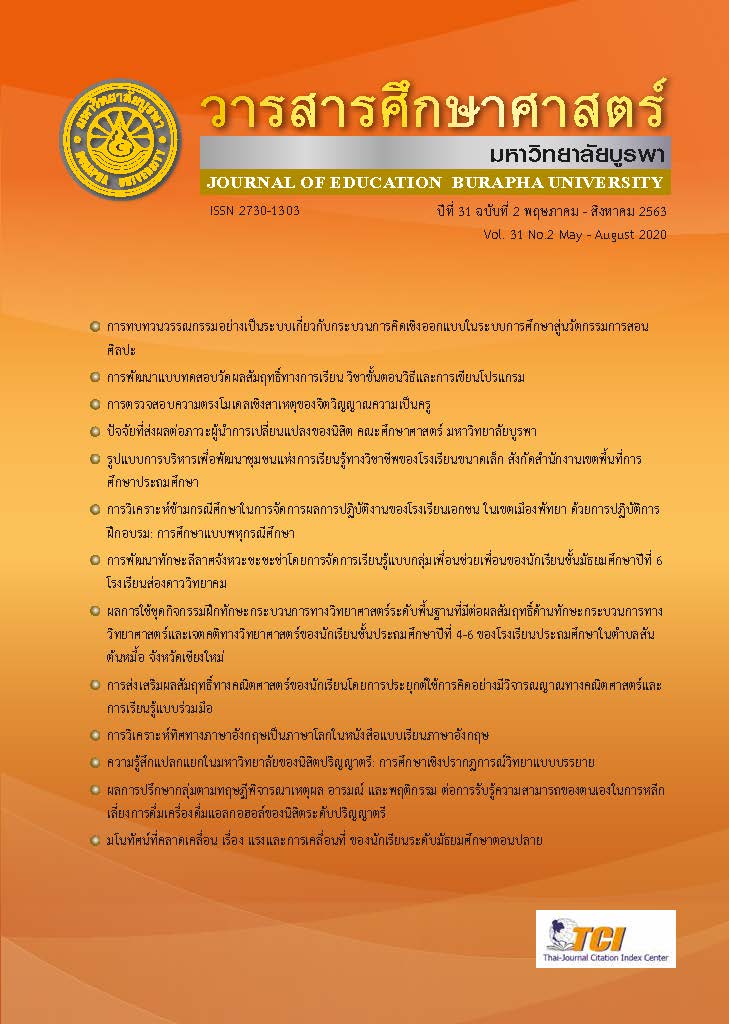การส่งเสริมผลสัมฤทธิ์ทางคณิตศาสตร์ของนักเรียนโดยการประยุกต์ใช้การคิดอย่างมีวิจารณญาณทางคณิตศาสตร์และการเรียนรู้แบบร่วมมือ
คำสำคัญ:
การคิดอย่างมีวิจารณญาณในวิชาคณิตศาสตร์, การเรียนแบบร่วมมือบทคัดย่อ
วัตถุประสงค์ของการวิจัยปฏิบัติการในชั้นเรียนนี้เพื่อเพิ่มผลสัมฤทธิ์ทางการเรียนคณิตศาสตร์ของนักเรียน และสำรวจความพึงพอใจของนักเรียนในการเรียนด้วยการประยุกต์ใช้การคิดอย่างมีวิจารณญาณในวิชาคณิตศาสตร์และการเรียนแบบร่วมมือ กลุ่มนักเรียนที่ใช้ในการวิจัยครั้งนี้เป็นนักเรียนระดับชั้นมัธยมศึกษาปีที่ 4 ของโรงเรียนระดับมัธยมศึกษาแห่งหนึ่ง ในกรุงเทพมหานคร ในภาคเรียนที่ 1 ปีการศึกษา 2559 จำนวน 50 คน ในหัวข้อเรื่อง เซต ผู้วิจัยพัฒนาแผนการสอน 8 แผนที่บูรณาการการคิดอย่างมีวิจารณญาณในวิชาคณิตศาสตร์และการเรียนแบบร่วมมือ เพื่อเพิ่มผลสัมฤทธิ์ทางคณิตศาสตร์และสำรวจความพึงพอใจของนักเรียน การเรียนการสอนใช้เวลา 12 คาบ คาบละ 50 นาที มีการสะท้อนผลการสอน 3 ครั้ง ข้อมูลรวบรวมจากแบบทดสอบวัดผลสัมฤทธิ์ทางการเรียนคณิตศาสตร์ของนักเรียน แบบสำรวจความพึงพอใจและการสะท้อนผล วิธีการวิเคราะห์ข้อมูลใช้ ค่าเฉลี่ย ร้อยละ ฐานนิยม และส่วนเบี่ยงเบนมาตรฐาน ผลการวิจัยพบว่านักเรียนร้อยละ 88 ของนักเรียนทั้งหมดมีผลสัมฤทธิ์ทางการเรียนคณิตศาสตร์ผ่านเกณฑ์ร้อยละ 70 ของคะแนนทั้งหมด และจากการสำรวจความพึงพอใจของนักเรียนพบว่านักเรียนมีความพึงพอใจในระดับสูง (ระดับความพึงพอใจมาก หรือพึงพอใจ) ในด้านสมรรถภาพส่วนตัวนักเรียน ในด้านการร่วมมือกันของนักเรียนและในด้านความเข้าใจของนักเรียน
เอกสารอ้างอิง
Anaduaka, U. S., Sunday, A. O., & Olaoye, A. E. (2018). Effect of Think-Pair-Share Cooperative Strategy on Mathematics Achievement of Attention-Deficit Hyperactive Students. Abacus. 43. 41-50.
Anderson, L. W., & Krathwohl, D. R. (2001). A Taxonomy for Learning, Teaching and Assessing: A Revision of Bloom’s Taxonomy of Educational Objectives: Complete Edition. New York: Longman.
Ayal, C. S., Kusuma, Y.S., Sabandar, J. & Dahlan, J. A. (2016). The Enhancement of Mathematical Reasoning Ability of Junior High School Students by Applying Mind Mapping Strategy. Journal of Education and Practice, 7(25), 50-58.
Bhat, M. A. (2014). Effect of Problem Solving Ability on the Achievement in Mathematics of High School Students. Indian Journal of Applied Research, 4(8), 685-688.
Chukwuyenum, A.N. (2013). Impact of Critical thinking on Performance in Mathematics among Senior Secondary School Students in Lagos State. Journal of Research & Method in Education. 3(5). 18-25.
Jacob, S. (2012). Mathematical Achievement and Critical Thinking Skills in Asynchronous Discussion Forums of Engineering Mathematics. Procedia - Social and Behavioral Sciences. 31. 800-804.
Koshy, V. (2005). Action Research for Improving Practice: A Practical Guide. London: SAGE.
Krulik, S., & Rudnick, J. A. (1999). Innovative Task to Improve Critical – and Creative Thinking Skills. In L. V. Stiff & F. R. Curcio (Eds.) Developing Mathematical Reasoning in Grade K–12, 1999 Yearbook (pp. 138-145). Reston, VA: NCTM.
Lester, F. K., Jr., (Ed.). (2007). Second handbook of research on mathematics teaching and learning. Charlotte, NC: Information Age.
Maiti, S. (2017). Impact of Reasoning Ability on Mathematics Achievement. International Journal of Research and Scientific Innovation, 4(6), 111-113.
Ministry of Education. (2008). The Basic Education Core Curriculum. Bangkok: Kurusapa Ladprao Publishing.
Monteleone, C., White, P. & Geiger, V. (2018). Defining the Characteristics of Critical Mathematical Thinking. In Hunter r, J., Perger, P., & Darragh, L. (Eds.). Making waves, opening spaces. Proceedings of the 41st annual conference of the Mathematics Education Research Group of Australasia (pp. 559-566). Auckland, New Zealand.
Noohi, K., Komsari, S., Nakhaee, N., & Yazdi, F. V. (2013). Reasons for Discharge against Medical Advice: A Case Study of Emergency Departments in Iran. International journal of health policy and management, 1(2), 137–142.
OECD. (2014). PISA 2012 Results: What Students Know and Can Do Student Performance in Mathematics, Reading and Science. revised edition (February). Volume I: OECD Publishing
Siegel, C. (2005). Implementing a Research Based Model of Cooperative Learning. The Journal of Educational Research. 98 (6). 1-15.
Slone, N. C. & Mitchell, N. G. (2014). Technology-based adaptation of think-pair-share utilizing Google drive. Journal of Teaching and Learning with Technology, Bloomington. 3 (1). 102-104.
The Institute for the Promotion of Teaching Science and Technology. (2016). Summary Report of research project TIMSS 2015. Bangkok, Thailand.
The National Institute of Educational Testing Service. (2016). O-NET test of 8 subject areas for the fourth level (secondary grades 4-6), the third level (secondary grades 1-3), and the second level (primary grades 4-6). The National Institute of Educational Testing Service (public organization), Bangkok.
Wong, K. Y. (2012). Use of student mathematics questioning to promote active learning and metacognition. In S. J. Cho (Ed.), Proceedings of the 12th International Congress on Mathematical Education (ICME-12) (pp. 1086-1100). Seoul, South Korea: Springer International Publishing.
ดาวน์โหลด
เผยแพร่แล้ว
รูปแบบการอ้างอิง
ฉบับ
ประเภทบทความ
สัญญาอนุญาต
บทความทุกบทความเป็นลิขสิทธิ์ของวารสารศึกษาศาสตร์ มหาวิทยาลัยบูรพา



